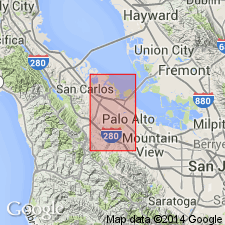
- Usage in publication:
-
- Whiskey Hill Formation*
- Modifications:
-
- Named
- Biostratigraphic dating
- Dominant lithology:
-
- Sandstone
- Siltstone
- Claystone
- Conglomerate
- AAPG geologic province:
-
- California Coast Ranges province
Summary:
Whiskey Hill Formation is named for Whiskey Hill in the southwestern part of the Palo Alto 7.5' quad, San Mateo Co, CA. Type area is in the northwest part of T6S R3W, east of the San Andreas fault. Occurs in the Santa Cruz Mountains (and foothills) in the southwestern part of the Palo Alto 7.5' quad. Consists of interlayered sandstone, siltstone, and claystone with minor conglomerate or conglomeratic beds, glauconitic sandstone, and tuffaceous siltstone. Thickness is estimated to be 3000 to 4000 ft. Base of unit is locally faulted on, and lies unconformably elsewhere on, the Franciscan Complex, and appears to interfinger laterally with unnamed Eocene sandstone beds; unconformably overlain by the Page Mill Basalt. Age is early to late Eocene based on fossils [foraminifers] and unit and regional stratigraphic relationships.
Source: GNU records (USGS DDS-6; Menlo GNULEX).
For more information, please contact Nancy Stamm, Geologic Names Committee Secretary.
Asterisk (*) indicates published by U.S. Geological Survey authors.
"No current usage" (†) implies that a name has been abandoned or has fallen into disuse. Former usage and, if known, replacement name given in parentheses ( ).
Slash (/) indicates name conflicts with nomenclatural guidelines (CSN, 1933; ACSN, 1961, 1970; NACSN, 1983, 2005, 2021). May be explained within brackets ([ ]).

